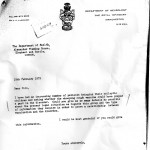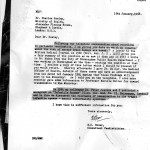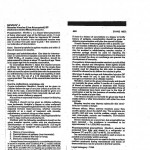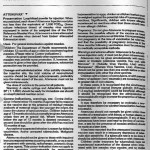
The UK Health Authorities are considering making vaccinations compulsory for newborns, vaccinating them with the DPT at birth due to the whooping cough outbreaks in the UK. The BBC News reported that number of cases in England and Wales are already three times higher than those in 2011. (1)
SO, HOW SAFE IS IT TO GIVE NEWBORN BABIES THE VACCINATION?
First introduced to the UK in the 1940’s, the DPT is a vaccination for Diphtheria, Pertussis (whooping cough) and Tetanus. Since the introduction of the vaccination the whooping cough element in particular has caused huge controversy and outrage among parents and professionals alike. This is largely due to serious adverse reactions being reported, including convulsions, neurological disorders and sudden infant death syndrome.
During the sixties, seventies and eighties various documents proved that a number of doctors, pediatricians and neurologists were writing to the government outlining cases of seizures and mental retardation (as it was called at the time) following vaccination.
In January 1968 B.D. Bower a consultant pediatrician from The Radcliffe Infirmary (2) wrote a letter to Dr Sealey Ministry of Health stating:
“Following our telephone conversation about reactions to pertussis vaccination, I am giving you data on which my remarks about the risk of severe brain damage are based.”
A little further on in his letter Bower states:
“In 1964 my colleague Dr Peter Jeavons and I published a monograph on ‘Infantile Spasms’ (Clin. Dev. Med. No 15,Heinemannms London) and in this we discussed the relevance of immunization to the tragic infantile spasms – mental subnormality syndrome.”
It is clear from Bower’s letter that all was not good and my research shows that the UK government received such letters on a regular basis. However, they did very little about this as the whooping cough vaccine continued to be problem.
In 1979 D Neary M.D. a Consultant Lecturer in Neurology wrote a letter to the Department of Health (3) He wrote:
“I have an increasing number of patients bringing their epileptic children and asking whether the whooping cough vaccine could have played a part in the disorder. Could you give me as many details as possible about the present legal situation as regards this group and the type of information they require in order to prove a relationship between vaccination and the disorder.”
[contentbox headline=”Tip” type=”attention”]Click on the graphic thumbnails below to read the enlarged documents. Please be patient while they open.[/contentbox]
[columnlayout]
[columncontent width=”25″] [/columncontent]
[columncontent width=”25″]
[/columncontent]
[columncontent width=”25″] [/columncontent]
[columncontent width=”25″]
[/columncontent]
[columncontent width=”25″] [/columncontent]
[columncontent width=”25″]
[/columncontent]
[columncontent width=”25″] [/columncontent]
[/columnlayout]
[/columncontent]
[/columnlayout]
Despite growing evidence that there was a problem the situation continued throughout the decades. In 1980 Professor Gordon Stewart made his feelings very clear as he felt that the government was withholding important evidence and information regarding the truth of this vaccination from the public. In a letter to Mr. P. Allen of the Committee for the Safety of Medicine (4) (5) (6) he wrote:
On page one he wrote:
“In reply to yours of the 11th February, I am sorry to say that I do not agree with you that there is nothing more that can or should be done. Let me say again the important matter confronting us is the safety of the vaccine. It is not in the publics interest to withhold additional information relating to the safety of the vaccine, which has come to our attention as a result of a collaborative programme and which is highly germane to our report.”
He continued on page two with the following:
“The situation changed when Dr Pollock saw fit to assure the public on more than one occasion that the vaccine was “perfectly safe”, that fears which had been expressed were groundless and that parents and doctors could therefore use it without fear. The reassuring statements issued by Sir Charles Stuart-Harris and by Professors Dudgeon and Miller were in the same vein, although NCFS to which they refer is nowhere near completion. This was so much at variance with what by that time, our Committee knew to be the case that a caution if not a corrective statement was certainly called for. The lack of a corrective statement amounts to a repetition of the same dismal history which caused the problem in the first place and led the Ombudsman to blame your Department in no uncertain terms.”
In his letter Professor Gordon’s makes it very clear that the government knew that there was a problem with this vaccine but was choosing to ignore it. However, it was not just the whooping cough element that was proving a problem. The DPT vaccine as a whole had been causing huge problems as a document published by the WHO (World Health Organization) in 2000 (7) proved.
The WHO reported the following:
“Vaccines against diphtheria, pertussis and tetanus (DPT)
Minor local reactions such as pain, oedema and erythema occur in 40% to 80% of cases when DTP vaccine is administered. In rare cases, a nodule can form at the point of injection and remain there several weeks. A sterile abscess appears in 6 to 10 cases per million doses administered.
Mild systemic reactions consist of temperature over 38°C and irritation (40% to 75%), drowsiness (33% to 62%), loss of appetite (20% to 35%), and vomiting (6% to 13%).
Severe adverse events
- Specific severe adverse events are described:
- Persistent, inconsolable crying for more than three hours (mostly from pain, 1%).
- Temperature in excess of 40.5°C (0.3%).
- Unusual screams (0.1%).
- Convulsions (usually related to fever, one case in 12 500 does administered) (Farrington et al., 1995).
- Hypotonic–hyporesponsive episodes (one case in 1750 doses administered)(Cody, 1981).
- Anaphylactic reactions are rare (two cases in 100 000 doses administered) (Edwards et al., 1999; CDC, 1996).
- Convulsions are more frequent when there is a personal history (with a relative risk of 6.4) or a family history (relative risk of 2.4) of convulsions in the child
- (Edwards et al., 1999; Livengood, 1989). There was an increased relative risk for convulsions 0–3 days after DTP vaccination (Farrington, 1995).
- Systematic administering of acetaminophen or any appropriate antipyretic at the time and at 4 and 8 hours after immunization decreases the subsequent incidence of febrile and local reactions (AAP, 1997). It may also be of benefit if there is a personal or family history of convulsions (Ipp et al., 1987; CDC, 1987).”
The author did go on to add:
“The US Vaccine Safety Committee agreed in 1994 that there was insufficient evidence to conclude that pertussis vaccine could cause permanent brain damage (Edwards et al., 1999). Furthermore, the experts rejected the alleged causal link between DTP vaccine and autism, infant spasms, Reye syndrome and sudden infant death syndrome.”
Although my evidence from doctors, pediatricians and neurologists paint a different picture.
In 2009 the UK Discussed Making the MMR Compulsory
This is not the first time that the UK has tried to make vaccinations compulsory. In 2009 the British Medical Association was calling for the MMR vaccination to be made compulsory due to the fall in vaccination rates of the under 5 year olds. (8)
If the UK Health Authority is discussing making the DPT vaccination compulsory for newborns and succeeded the news recently announced on WDDTY (What Doctors Don’t Tell You) news site may be accurate.
The controversial website WDDTY (9) recently announced that the DPT was not the only vaccination likely to be made compulsory for newborns in the UK. They reported that the BBC had also announced that the UK Health Authority was also discussing making the MMR vaccine compulsory for newborns as well.
I was unable to verify their news source but if this is the case how dangerous could the MMR potentially be in newborns.
How Dangerous in the MMR for Newborns?
In 2010 I exposed a series of hidden documents that I stumbled across whilst researching at the Kew Archives. One of the documents that I exposed was a Ministry of Health Circular released in September 1968. (10)
Section 7 – Routine Vaccination of the circular stated that:
“Live measles vaccine should not be given to children below the age of nine months since it usually fails to immunise such children, owing to the presence of maternally transmitted antibodies.”
The circular advised that the measles vaccination should instead be given to children in their second year of life after the completion of the immunisation against diphtheria, tetanus whooping cough and polio.
This is interesting because the advice given by the Ministry of Health matches the advice given by Thomas Morson Pharmaceuticals in their manual for the single measles vaccination Attennuvax. (11) The manual states:
“Infants below 15 months of age may fail to respond to the vaccine due to the presence of residual measles antibody of maternal origin: the younger the infant the lower the chance of seroconversion. Children below 12 months should not normally be given Attenuvax unless they are at special risk.”
Yet more advice warning about the dangers of the single vaccines being given to very young children can also be found in the product license for the single measles vaccine, Mevilin L. Mevilin L is a measles vaccine containing the live attenuated measles strain Schwartz , the exact strain used in MMR vaccines today.
The product license reads: (12)
“Mevilin L should not be given to children under the age of one year of age unless at special risk.”
More crucially the license says:
“The vaccine should not normally less than three weeks before or after immunization with any other live virus vaccines.” (emphasis added)
All this important advice fell on deaf ears however, because by 1988 the Schwartz strain of measles was incorporated with two other live virus vaccines to become the MMR’ Pluserix.
The Measles Vaccination Becomes the MMR
In 1988 the MMR triple vaccine Pluserix was introduced into the UK by the JCVI after being banned in Canada. It wasn’t long however, before the Pluserix vaccine was found to cause severe side effects including encephalitis, meningitis deafness and death.
In 1992 seeing the error of their ways the UK finally banned the MMR vaccine Pluserix and replaced it with Mercks MMRII alongside other MMR vaccines.
Jumping Forward to 1998
In 1998 the JCVI (Joint Committee on Vaccination and Immunization) (13) stated the following side affects had been reported in relation to the MMR at a meeting held on Friday October 30th.They said:
“An increase had been noted in some areas in some (ADRS) reported on the Yellow Card scheme, mainly developmental autism or autism spectrum disorder (ASD) related to the MMR vaccine. Chronic bowel problems and epilepsy had been reported as well. Other conditions noted were deafness, Insulin Dependent Diabetes Mellitus (IDDM) and Myalgic Encephalitis (in older recipients). 91% of the reported cases had received the MMR by 18 months of age.” (emphasis added)
This statement included crucial evidence of harm being reported to the yellow card reporting system and yet this evidence has been repeatedly ignored throughout the years as the evidence that Mark R Geier, M.D, PhD and David A. Geier reported proved in 2003.
In 2003 Mark R Geier, M.D, PhD and David A. Geier wrote a Clinical Article titled ‘Pediatric MMR Vaccination Study’ published in International Pediatrics/Vol. 18 (14). The aim of the study was to analyze the incidence of serious neurological disorders in comparative examination between MMR vaccine and a vaccine control group.
During their discussion they wrote:
“These results show that primary pediatric MMR vaccination in children is associated with a marked increase in serious neurologic disorders in comparison to DTwcP vaccination. The increase is statistically significant for cerebella ataxia , autism, mental retardation and permanent brain damage following primary pediatric MMR vaccination in comparison to DTwcP Vaccination. These results are remarkable considering that DTwcP vaccination has been found by the scientific and medical communities to be responsible for permanent neurologic sequellae in children.”
It appears from their results that little had changed through the years, even though the MMR was very definitely responsible for neurological disorders in a number of their subjects.
CONCLUSION
Given the factual evidence that I have outlined from government papers, letters and peer reviewed studies is it a wise move for newborn babies to be vaccinated from birth with either or both of these vaccines? Many newborns are sick and frail due to being born earlier and earlier in pregnancy. It is my opinion that governments around the world are introducing too many vaccinations too soon and rather than prevent illness these vaccines could potentially cause more disabilities and death in very young children.
[contentbox headline=”” type=”info”]We are publishing this information to educate Congress, the media, and public regarding issues affecting the health and well-being of our citizens. It is not our intention to infringe upon anyone’s copyright. We believe we have used the U.S. Copyright’s Doctrine of Fair Use equitably and without incurring infringement or plagiarism.[/contentbox]References
- BBC News http://www.bbc.co.uk/news/health-19454493
- Letter from B.D Bower to Dr Charles Sealey Ministry of Health 1968 retrieved from the Kew Archives. http://www.nationalarchives.gov.uk/catalogue/search.asp?j=1
- Letter from D Neary M.D, MRCP Consultant Lecturer in Neurology to The Department of Health 1979 retrieved from the Kew Archives. http://www.nationalarchives.gov.uk/catalogue/search.asp?j=1
- Letter from Professor Gordon Stewart to Mr P Allen Secretary of CSM 1980 Page 1 http://www.profitableharm.com/Professor%20Gordon%20Stewart%20letter%20to%20P%20Allen%20-%20Committee%20on%20Safety%20of%20Medicines.html
- Page Two http://www.profitableharm.com/Professor%20Gordon%20Stewart%20letter%20Page%20Two.html
- Page Three http://www.profitableharm.com/page3.html
- supplementary information on vaccine safety Part: 2 Background rates of adverse events following immunization’ World Health Organization Geneva 2000 DEPARTMENT http://www.who.int/vaccines-documents/DocsPDF00/www562.pdf
- Call to make MMR Jab Compulsory http://news.bbc.co.uk/1/hi/health/8078500.stm
- WDDTY Compulsory vaccines for newborns ‘a consideration’ in the UK http://www.wddty.com/compulsory-vaccines-for-newborns-a-consideration-in-the-uk.html
- Link to the Government JCVI document 1968 can be found http://vactruth.com/2010/05/20/government-papers-on-measles-vaccines-exposed/
- Thomas Morson Pharmaceuticals Division of Merck Sharpe & Dohme Limited Attenuvax
- Mevilin Product Licence 0021/0059
- JCVI minutes from Friday 30th October 1998 http://www.advisorybodies.doh.gov.uk/jcvi/foi-2005-minutesOct98.pdf
- Mark R Geier, M.D, PhD and David A. Geier – Pediatric MMR Vaccination Study – International Pediatrics/Vol. 18/No. 2/2003 http://icdrc.org/documents/MMRresearch.pdf
